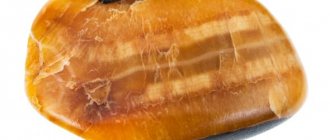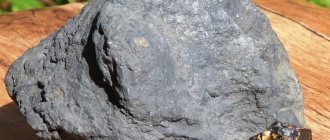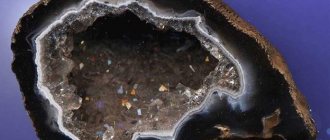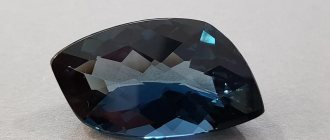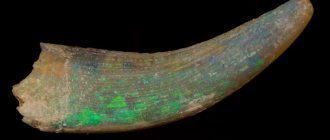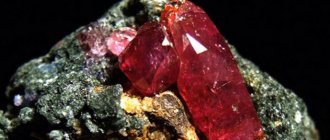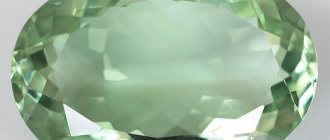Serpentine stone is one of the most beautiful minerals. In addition, it is called serpentine due to its external features: the mineral resembles snake skin due to original stains across the entire surface. The name of the stone also comes from the word serpens, which means “snake”.
Serpentine stone is one of the most beautiful minerals
Description of the stone
In appearance, serpentine is often confused with jadeite or jade, but it has a softer structure. The main color of the stone is green and all its shades; red and green serpentines are less common.
This mineral has a matte or waxy luster. As a rule, serpentine is characterized by opacity, but in some cases it can be translucent. The mineral has perfect cleavage and relatively low hardness; it is easy to polish and various types of processing. The fracture is usually uneven and even conchoidal.
Its natural origin makes the serpentine mineral suitable not only for decoration, but also for treatment. Its properties have been studied for centuries and are confirmed by facts.
Depending on the characteristics, there are two types of serpentine:
- antigorites;
- ophite, otherwise serpophyte.
The first mineral exfoliates perfectly, the second has a transparent but dense structure. Serpophyte is considered a noble variety of serpentine. Its special structure is explained by the high water content in the mineral. They belong to the chrysotile category.
Deposits of this mineral are found in the vicinity of rocks where the concentration of asbestos is quite high. In Russia, rock deposits are located in the Orenburg region, Transbaikalia, the Urals and the North Caucasus, where asbestos deposits are located. Like all chrysotiles, serpentine seeks precisely such places to form. Associated minerals are olivine, bronzite (bastite), garnet (pyrope), chlorites, chromite, magnetite, magnesite, opal, chalcedony.
Physical properties of stones
- Chemical composition: silicon dioxide, water.
- Presence of impurities: aluminum, manganese, iron, magnesium.
- Dependence on humidity: high, containing more than 13% water.
- Stone structure: amorphous.
- Glitter of the stone: matte, waxy, glassy, mother-of-pearl.
- Hardness: up to 6.5 units on the Mohs scale.
- Alkali resistance: low.
The stone is opal
In nature, there are no two absolutely identical gems. All of them will be at least slightly different in shades, sizes and structure.
What does the mineral treat?
The spectrum of therapeutic effects of serpentine, or serpentine, is quite wide. The balls that are made from it are successfully used both for healing broken bones and for eliminating persistent insomnia. In the first case, the stone must be periodically rolled over the problem area, in the second, you must look at it carefully every day before going to bed.
It has been proven that serpentine can warn its owner about an approaching illness: in this case, it heats up unnaturally and literally burns the skin.
Interestingly, many pharmacists use serpentine utensils to prepare medications, believing that this enhances the effect of medicinal substances.
Magical properties of opal
The magical properties of the stone are as strong as their healing ones. He is the main amulet that protects against the evil eye and damage. It prevents dark forces and curses from harming a person at the energetic level. If the mineral is always kept at home, it will protect it from robbers and other troubles. He is the main assistant in maintaining warm and harmonious relationships in the family, and makes it possible to avoid quarrels and conflicts.
The main magical properties of the gem:
- Helps get rid of absent-mindedness and forgetfulness, makes a person more collected and organized.
- Affects human consciousness.
- Favors coordination of actions at sports competitions.
- Helps to restore order in the house and keep it clean.
- Allows business people to better cope with organizational activities.
In different countries at all times, the gem has meant hope, mercy, fidelity, love and prosperity. They preferred to make jewelry for royalty and monarchs from this stone: according to legend, it brought peace and harmony to a person’s life and effectively protected against any type of evil eye.
The mineral is capable of transferring its magical powers to humans: the most sensitive people may develop the gift of clairvoyance and divination, and develop intuition well.
Opal colors
How to use?
Serpentine can not only be used for medicinal purposes, but also worn as a talisman. It is believed that it is most suitable for such zodiac signs as Capricorn, Virgo, and is contraindicated for Pisces and Cancer as emotional, stress-resistant individuals.
In ancient times, stone amulets were worn as a talisman against snake bites and to attract success. As for the latter, in the modern world there are people who believe in such properties of serpentine. In addition, it is believed that the mineral strengthens the spirit, gives it perseverance, and charges a person with positive emotions.
However, in ancient times this mineral was inaccessible to mere mortals; it could only be used for personal purposes and for rituals by special people - magicians and sorcerers. They already knew then that the stone cleanses the human astral body of various impurities and toxins. As a result, headaches and joint pain go away, and significant relief occurs almost immediately. A person gains freedom of thought and action.
Serpentine is often used to make decorative interior items. This applies to ashtrays, stands, clocks, figurines, and wall tiles. Minerals of the serpentine group are formed primarily through the chemical alteration of magnesian olivine, orthorhombic and monoclinic pyroxenes. Rocks consisting mainly of the described minerals are called serpentinites. Among them are garnet (pyrope), bronzite, iron-poor (yellow, green) and nickel-rich serpentinites.
Thus, serpentine is not only a beautiful mineral that is appropriate in jewelry, but also a stone that has truly magical properties. Serpentine helps a person get rid of many diseases, adds health and well-being. This is a great purchase and a great gift for any occasion. In such a wide use of serpentine.
Healing properties of opal
The mineral is not only beautiful, but also strong in energy. It has powerful magical and healing properties, so in folk medicine it is used not so much as a decoration, but as a talisman.
When can opal help? If you have the following health problems:
- diseases associated with the cardiovascular system;
- eye diseases, such as glaucoma or cataracts;
- depressive states and various mental illnesses;
- migraines, work or study stress, irritability and neuroses;
- pathologies of reproductive function in women;
- phobias, insomnia and anxiety.
It has an overall positive effect on the human body, helping him feel better and more confident. It is recommended to carry with you for preventive purposes to prevent colds. Traditional healers have a belief that the gem helps not to get sick even during epidemics raging in the city. And also when building relationships between people.
Blue opal "Universe"
Stone care
Proper care of the stone will keep the jewelry safe and sound for a long time. First of all, you need to keep opal away from other heavy and rough stones: they damage the fragile structure. The solution to this problem would be canvas bags, in which it would be best to store jewelry.
Other tips for proper product care:
- You should always remove jewelry before bathing or showering.
- It is important to keep the stones clean every day: wipe with a damp cloth once a day, wash in a warm soapy solution about once every three to four weeks.
- Prevent contact of the product with hot water, it will deform the stones.
- If you need to style your hair, you should put on opal jewelry after the curling is completed.
- It is better to hide the jewelry under clothes during severe frosts or put on the jewelry already in place.
- Since the mineral reacts strongly to moisture, it is best to store it in rooms with low humidity levels. Upon contact with water, the mineral becomes cloudy, but later returns to its original appearance under normal conditions.
Jewelry with blue opal
Unfortunately, it is impossible to return a stone to its original appearance if it has already been damaged. Therefore, it is recommended to carefully follow the advice, and then jewelry with opal will delight you with beauty and grace for many years to come!
Types of opals
Minerals are one of the most diverse components of stones. There are more than 140 of them in total. In turn, these types are divided into precious and semi-precious stones. They differ in the effects they provide, colors and other physical properties, but they are all united by beauty and grace.
The most popular gemstones are:
- Harlequin is unusual and beautiful; it got its name not by chance, but because it has a bright multi-colored color, like the costume of the popular hero of the Italian commedia dell'arte.
- Cat's eye is an opal that usually has a yellowish tint. Indeed, it is very similar to a cat’s eye: in the middle of the stone there is a vertical light stripe.
- Royal, or royal, is a true gem of royalty. It is bright red in color, except for the edges: they are green on the opal, which makes the color very unusual.
- Sun opal, or jirazole, is a transparent gem of a bluish-yellow hue.
- Lejos is a green opal with emerald stripes or inclusions.
Pearl opal
Popular semi-precious stones include the following types of opal stone:
- Prosopal (chrysopal) is an opal very similar in color to a green apple.
- Cacholong is a white, milky gemstone that has been considered a symbol of female love and motherhood since ancient times.
- Water opal, or hydrophane, initially has a porous and translucent structure, but if the mineral is placed in water for a while, it will become almost completely transparent.
- Opal-agate, which includes another semi-precious gem with strong energy - agate. It is located on the stone in stripes.
- Opal-onyx is a combination of two minerals. It has a yellowish color with rusty stripes.
- Opal jasper is a very bright and beautiful red or red colored gem. Such shades are explained by the high iron content in the mineral.
- Gualite is transparent, light in color, similar to glass.
- Brazilian opal is a mineral that contains the least amount of water and is the most durable of all its representatives. These are transparent stones of a fiery hue.
- Dendrite opal is a popular type among collectors. It is milky bluish in color, and black inclusions create natural patterns of twigs and trees directly on the mineral.
- Peruvian opal gets its name from where it is mined. The mineral is bluish or turquoise in color.
